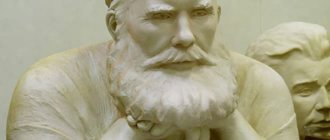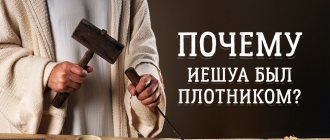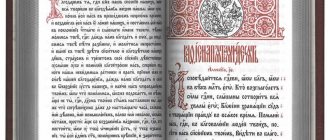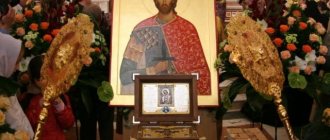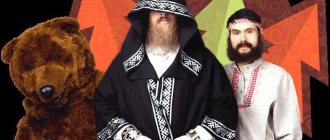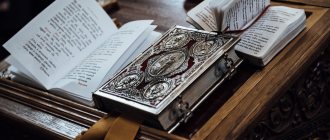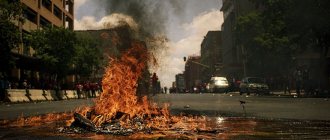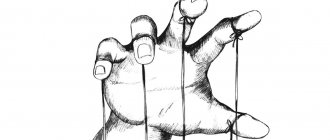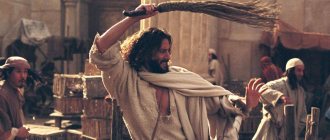An Orthodox person could pray to a “demonic” icon for years. The worst thing was that he didn't even know about it. The devils hid themselves skillfully. When the true origin of the image was revealed, the believer was seized with horror.
It is still not known why the hellish icons were created and who dared to paint them. Some art historians are convinced that the images are a grandiose cultural myth.
The first "demonic" icon
According to legends, people first encountered such images in the 16th century. The Life of St. Basil tells about the strange act of the saint. In front of the believers, the saint threw a stone at the icon on which the Mother of God was depicted. The pilgrims were dumbfounded. The image was considered miraculous and they prayed intensely to it.
Having hit the icon, the stone exposed its terrible insides. Devils and other evil spirits appeared. The saint gradually removed all the paint. There was a devil or a devil on every centimeter. The image was removed out of sight and immediately burned.
In the 19th century, hellish icons were also popular. However, most often they were perceived as fakes. The clean top writing on the images was extremely unskillful.
The story of the holy fool Vasily
According to the apocrypha, “a certain lover of Christ” ordered an icon from an “isographer,” but the icon painter was overcome by the devil, who ordered him to paint his portrait and cover it with the face of the Most Pure Virgin. For this he gave the “izograph” 50 zlatnikov. The ignorant customer took the icon “with great faith and love” and hung it over the Varvarovsky Gate of Kitai-Gorod, where the icon was worshiped by everyone who passed under it: and from this icon many miracles happened, performed by devilish power. Allegedly, blessed Vasily, who has the gift from God to see the “spiritual eyes,” saw that the face of Satan was hanging over the gate and threw a stone at the image with such force that “it split it in two.”
The holy fool was beaten by an indignant crowd and handed him over to the authorities, who already reported to Tsar Ivan IV. During interrogation by the king, the blessed one told about the hidden appearance of the devil under the image of the Virgin.
When the icon painter was brought to the king, he confessed everything. Each received what they deserved: “izgraf” - the death penalty, and Vasily - freedom.
To be fair, it is worth pointing out that the apocrypha with the story about the icon, published only in 1910, did not arise out of nowhere: under Tsar Peter Alekseevich, an icon of the Mother of God of Bogolyubskaya appeared on the gate, which is associated with the beginning of the Plague Riot of 1770. During the epidemic, believers removed the icon from the gate so that everyone could venerate and be healed, but Archbishop Ambrose, a member of the Holy Synod, ordered the icon to be removed, fearing that the pestilence would spread among the crowd. An angry crowd overtook the bishop in the Donskoy Monastery and killed him. The riot was suppressed only three days later.
Manufacturing technology and danger of use
Icons were made by special bogomaz. The images consisted of two layers. At first the artist painted devils, demons and the devil. Then the paint dried and a primer was applied on top. With the second layer, Bogomaz painted the familiar faces of saints. Thus, in order to discover the hellish icon, it was necessary to remove the top layer. Sometimes artists hid only small details under the inner layer. For example, horns or other devilish paraphernalia.
Such images posed a huge danger for an Orthodox person. Even though the two layers were separate, they were inextricably linked. It turns out that the man prayed to both the saint and the devil at the same time. For this reason, the Orthodox saw the machinations of warlocks in the hellish icons. Who actually painted these icons?
Black icons in our time
In our time, so-called black icons have appeared, but calling them hellish icons is not entirely correct. On hellish icons (if they really existed), the image of the devil and satanic forces was hidden, but on black icons it is openly demonstrated, and according to a clearly traceable principle: an image of a saint is taken, for example, Nicholas the Wonderworker, as in photo 1, and his bright face is distorted into an evil dark grimace, horns are added, etc.
Or, for example, the Face of the Savior is taken, to which infernal, devilish features are given, completely distorting the very Christian idea of \u200b\u200bmercy and salvation of the soul.
Many believers (and non-believers too) ask the question: what are these black icons? Black icons are considered an integral part of black magic and often provocatively parody common Christian subjects, such as the Virgin Mary with the Child Jesus or the Trinity, and all kinds of black magicians, sorcerers, etc. They don’t even hesitate to post them on the Internet.
Although some believe that hellish and black icons are the same thing, I think the difference is obvious, especially since no one has ever had the opportunity to hold an hellish icon in their hands. As for black icons, even an unbeliever understands that they are dirt and abomination.
( 1 ratings, average: 5.00 out of 5)
Why were hellish icons made?
There are two versions about why hellish icons were created. According to the first, “demonic” images were made by Old Believers. They deliberately placed devils under the face of the saints. This is how adherents of old traditions emphasized their attitude to church reforms. For the Old Believers, this was a kind of revenge for the adoption of the Greek canons of worship.
According to another version, the Old Believers were victims. They, like other Orthodox Christians, were sold icons by the ofeni. Cunning traders who put together a whole secret society received double benefits. The first ofenya came to the village and sold the demonic icon. After him, an accomplice visited the village. He lifted the paint with his fingernail and revealed the terrible secret of the icons. As a favor, the second ofenya offered to take the icons out of the city. And to replace them he sold new, most ordinary images.
Devil's Bible - contents
A huge ominous book is presented in the form of an ancient manuscript. According to a widespread theory, the attribute appeared at the beginning of the 13th century in the Benedictine monastery of the Czech city of Podlazice (now Hrast).
The Gigantic Codex has 624 pages, the height of the book is 89 cm, the width is 49 cm. The weight of the work is impressive - 75 kg. According to approximate data, 167 lamb skins were spent on the production of the manuscript.
According to one legend, Satan helped the monk in writing the book. Tradition says that in order to atone for a grave sin, a monk must rewrite the Bible in one night. Having taken up the work, the monk realized that this was impossible, and calling on Satan, he prayed to the Devil for salvation.
The codex was written in a handwriting atypical for the 13th century. The letters resemble printed ones. Today, scientists do not agree with the legend and are confident that the book’s production time was at least 20–30 years. M. Gulik confirmed this assumption by the fact that the medieval arctic fox was able to copy no more than 140 lines per day. Even non-stop work would have taken about 5 years to create the Bible.
The manuscript contains the Old and New Testaments, the texts of “Etymology” by Isidore of Seville, “The Jewish War” by Josephus, a calendar indicating the days of saints and various spells.
The original Codex Gigas (Devil's Bible) is on display in Prague's Clementinum Library.
A striking page is number 290, where both the usual biblical stories and a strange drawing supposedly depicting the Devil are located. Looking through the book, it is easy to determine that the sheet is different from the rest: the color is different, the style and color of the text are clearly different. It seems that the passage was written by another person.
An excursion into iconographic history
Now the status of the icon in Orthodox and Catholic Christianity is beyond doubt, but this was not always the case. For a long time, the issue of the use and veneration of icons was not only open, but also the subject of fierce debate. Thus, in Byzantium in the 8th–9th centuries, iconoclasm gained serious support. His supporters considered the veneration of icons to be idolatry. This was not about a secessionist group of heretics: the schism existed directly within the church, and the struggle between the parties went on with varying success. The final status of the permissibility and sacredness of icons was resolved only thanks first to the Second Council of Nicaea (787), and subsequently to the Council of Constantinople in 843. However, even then many issues in iconography had not yet been finally resolved.
How should one or another sacred images be conveyed, and how should this absolutely not be done? How to depict the Trinity, and is it appropriate to do this at all? How should the images of some saints, for example St. Christopher, the dog-headed martyr, be conveyed through painting? It should be understood that the main difficulties lay far from being in the area of artistic decisions: the icon painter was faced with a serious religious goal, controlled by the Church. On the one hand, the implementation of traditions was strictly monitored. On the other hand, they argued, questioned, and accused opponents of heresy or even witchcraft. Thirdly, the subjects of the icons and their execution had to be understandable to ordinary parishioners (as a rule, far from theological nuances), evoke in them God-fearing awe and involve them in thoughts about the eternal.
The content of some canons has not changed for centuries, while others have been refined over centuries. Sometimes unusual incidents occurred in this process. Thus, in the Middle Ages there was a widespread Catholic tradition of depicting the Old Testament prophet Moses with... horns. This was due to the peculiarity of the Latin translation of the Book of Exodus and the episode of the descent from Mount Sinai. Despite the prevalence of such an image, some of the medieval images of Moses have come down to us with a scraped, damaged face - according to historians, this was the “work” of individual impressionable parishioners who saw a hidden demon or devil in the prophet.
In Orthodoxy, the most resonant and significant process associated with internal disputes and contradictions was the church schism of the 17th century. The reform activities of Patriarch Nikon affected many church aspects and traditions, including those associated with icon painting. A significant part of believers categorically did not accept such changes, forming a heterogeneous movement of Old Believers. Mutual reproaches were heard from the two camps about deviations from the true canons and heresy.
What do the symbols on the icon mean?
Those who have seen the icon of the never-slumbering eye more than once remember its main distinctive features, clearly presented on this sacred canvas. The key details of the All-Seeing Eye icon fill the image with deep meaning, allowing people to form an important idea about the existence of the earthly world, which is under the influence of the almighty Jesus Christ.
The central figure of the icon is the image of Christ the Savior. Located in the circle of this iconographic composition, it emits a bright, blessed light that penetrates the souls of people praying for help.
Multiple eyes, which are represented in the inner part of the next, larger circle, are an expression of the relationship that can be traced between spiritual and earthly reality. Their quantitative diversity represents ordinary people who, despite their individual and seemingly independent existence, are completely under the influence of Jesus Christ.
In the third circle, the authors present the Holy Mother of God, who acts as the savior of sick and oppressed souls. She comes to the rescue when certain people have been destined for a difficult fate.
The last and perhaps most significant circle is dedicated to the Lord God. It is depicted at the top of this circle.
Being on a dais, he appears to be the main leader of the entire Kingdom of Heaven, which consists of various heroes of the Bible. From there, God extends blessings to all living and peaceful inhabitants.
Thus, the icon of the All-Seeing Eye of God allows us to emphasize the following important thoughts:
- Jesus Christ watches and observes all living people, some of whom he separately tries to help, radiating his beneficial light on them.
- Our Lady is the guardian and protector of people.
- The Lord God, the main peacemaker and world creator of all life on earth. At the same time, everyone submits to his authority.
